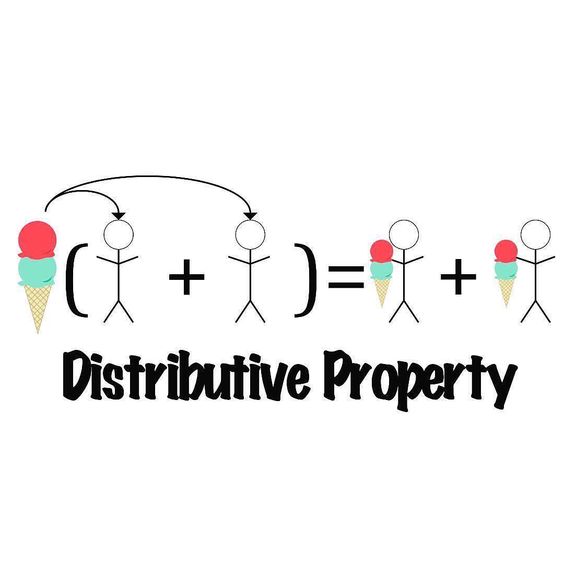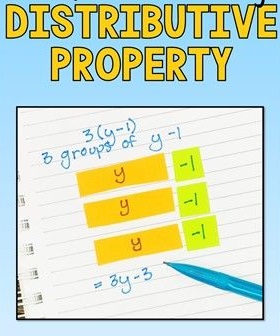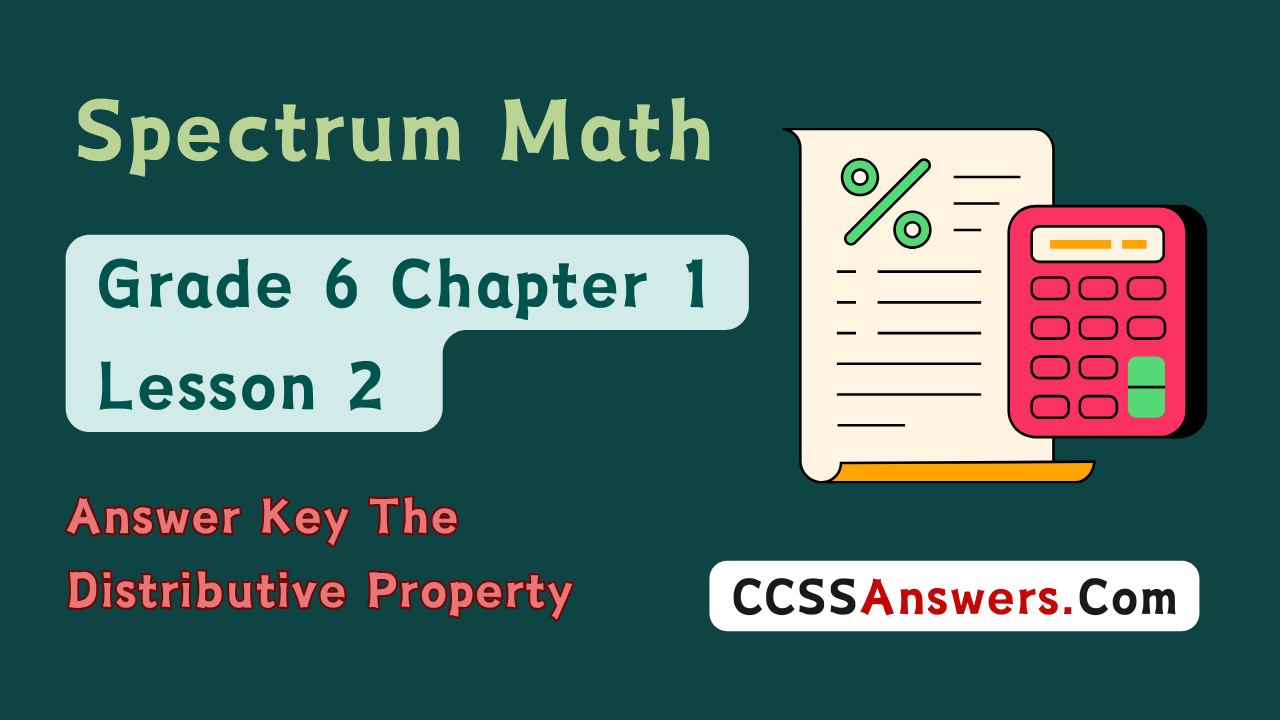Go through the Spectrum Math Grade 6 Answer Key Chapter 1 Lesson 1.2 The Distributive Property and get the proper assistance needed during your homework.
Spectrum Math Grade 6 Chapter 1 Lesson 1.2 The Distributive Property Answers Key
The Distributive Property combines the operations of addition and multiplication.
a × (b + c) = (a × b) + (a × c)
3 × (2 + 5)
3 × 7
21
(3 × 2) + (3 × 5)
6 + 15
21
Indicate which operation should be done first.
Question 1.
a. (2 × 5) + (2 × 3) ____
Answer:
(2 × 5) + (2 × 3) = 16.
Explanation:
The Distributive Property combines the operations of multiplication.
(2 × 5) + (2 × 3) = 2 × (5 + 3)
= 10 + 6
= 16.
b. 7 × (3 + 5) _____
Answer:
7 × (3 + 5) = 56.
Explanation:
The Distributive Property combines the operations of addition.
7 × (3 + 5) = (7 × 3) + (7 × 5)
= 21 + 35
= 56.
Question 2.
a. (6 + 9) × 4 ____
Answer:
(6 + 9) × 4 = 60.
Explanation:
The Distributive Property combines the operations of addition.
(6 + 9) × 4 = (6 × 4) + (9 × 4)
= 24 + 36
= 60.
b. (3 × 5) + (3 × 7) ____
Answer:
(3 × 5) + (3 × 7) = 36.
Explanation:
The Distributive Property combines the operations of multiplication.
(3 × 5) + (3 × 7) = 3 × (5 + 7)
= 3 × 12
= 36.
Rewrite each expression using the Distributive Property.
Question 3.
a. 4 × (6 + 2) = ____
Answer:
4 × (6 + 2) = 32.
Explanation:
The Distributive Property combines the operations of addition and multiplication.

4 × (6 + 2) = (4 × 6) + (4 × 2)
= 24 + 8
= 32.
b. (2 × 5) + (2 × 4) = ____
Answer:
(2 × 5) + (2 × 4) = 18.
Explanation:
The Distributive Property combines the operations of addition and multiplication.
(2 × 5) + (2 × 4) = 2 × (5 + 4)
= 2 × 9
= 18.
Question 4.
a. (5 × 1) + (5 × 6) = ____
Answer:
(5 × 1) + (5 × 6) = 35.
Explanation:
The Distributive Property combines the operations of addition and multiplication.
(5 × 1) + (5 × 6) = 5 × (1 + 6)
= 5 × 7
= 35.
b. 4 × (2 + 6) = ____
Answer:
4 × (2 + 6) = 32.
Explanation:
The Distributive Property combines the operations of addition and multiplication.
4 × (2 + 6) = 4 × 8
= 32.
Question 5.
a. 8 × (4 + 3) = ___
Answer:
8 × (4 + 3) = 56.
Explanation:
The Distributive Property combines the operations of addition and multiplication.
8 × (4 + 3) = 8 × 7
= 56.
b. (5 × 0) + (5 × 1) = ____
Answer:
(5 × 0) + (5 × 1) = 5.
Explanation:
The Distributive Property combines the operations of addition and multiplication.
(5 × 0) + (5 × 1) = 5 × (0 + 1)
= 5 × 1
= 5.
Write each missing number.
Question 6.
a. (5 × 3) + (n × 4) = 5 × (3 + 4) ____
Answer:
n = 5 in the equation (5 × 3) + (n × 4) = 5 × (3 + 4).
Explanation:
(5 × 3) + (n × 4) = 5 × (3 + 4)
=> (5 × 3) + (n × 4) = 5 × 7
=> (5 × 3) + (n × 4) = 35
=> 15 + 4n = 35
=> 4n = 35 – 15
=> 4n = 20
=> n = 20 ÷ 4
=> n = 5.
b. 7 × (n + 3) = (7 × 2) + (7 × 3) ____
Answer:
n = 2 in the equation 7 × (n + 3) = (7 × 2) + (7 × 3)
Explanation:
7 × (n + 3) = (7 × 2) + (7 × 3)
=> 7 × (n + 3) = 7 × (2 + 3)
=> 7 × (n + 3) = 7 × 5
=> 7 × (n + 3) = 35
=> 7n + 21 = 35
=> 7n = 35 – 21
=> 7n = 14
=> n = 14 ÷ 7
=> n = 2.
Question 7.
a. n × (5 + 3) = (6 × 5) + (6 × 3) ____
Answer:
n = 6 in the equation n × (5 + 3) = (6 × 5) + (6 × 3).
Explanation:
n × (5 + 3) = (6 × 5) + (6 × 3)
=> n × (5 + 3) = 6 × (5 + 3)
=> n × (5 + 3) = 6 × 8
=> n × (5 + 3) = 48
=> n × 8 = 48
=> n = 48 ÷ 8
=> n = 6.
b. (5 × 7) + (n × 4) = 5 × (7 + 4) ____
Answer:
n = 5 in the equation (5 × 7) + (n × 4) = 5 × (7 + 4).
Explanation:
(5 × 7) + (n × 4) = 5 × (7 + 4)
=> (5 × 7) + (n × 4) = 5 × 11
=> (5 × 7) + (n × 4) = 55
=> 35 + 4n = 55
=> 4n = 55 – 35
=> 4n = 20
=> n = 20 ÷ 4
=> n = 5.
Question 8.
a. (4 × 5) + (4 × 2) = 4 × (5 + n) ____
Answer:
n = 2 in the equation (4 × 5) + (4 × 2) = 4 × (5 + n).
Explanation:
(4 × 5) + (4 × 2) = 4 × (5 + n)
=> 4 × (5 + 2) = 4 × (5 + n)
=> 4 × 7 = 4 × (5 + n)
=> 28 = (4 × 5) + (4 × n)
=> 28 = 20 + 4n
=> 28 – 20 = 4n
=> 8 = 4n
=> 8 ÷ 4 = n
=> 2 = n.
b. 3 × (n + 5) = (3 × 4) + (3 × 5) ____
Answer:
n = 4 in the equation 3 × (n + 5) = (3 × 4) + (3 × 5).
Explanation:
3 × (n + 5) = (3 × 4) + (3 × 5)
=> 3 × (n + 5) = 12 + 15
=> (3 × n) + (3 × 5) = 27
=> 3n + 15 = 27
=> 3n = 27 – 15
=> 3n = 12
=> n = 12 ÷ 3
=> n = 4.
Replace a ,with 2, b with 5, and c with 3. Then, find the value of each expression
Question 9.
a. a × (b + c) = ___
Answer:
a × (b + c) = 16.
Explanation:
Substitute a = 2; b = 5; c = 3 in a × (b + c).
=> a × (b + c) = 2 × (5 + 3)
= 5 × 8
= 16.
b. (a × b) + (a × c) = ____
Answer:
(a × b) + (a × c) = 16.
Explanation:
Substitute a = 2; b = 5; c = 3 in (a × b) + (a × c).
=> (a × b) + (a × c) = (2 × 5) + (2 × 3)
= 10 + 6
= 16.
Question 10.
a. (c × o) + (c × b) = ____
Answer:
(c × o) + (c × b) = 8.
Explanation:
Substitute a = 2; b = 5; c = 3 in (c × o) + (c × b).
=> (c × o) + (c × b) = (3 × 0) + (3 × 5)
= 0 + 8
= 8.
b. b × (a + c) = ____
Answer:
b × (a + c) = 25.
Explanation:
Substitute a = 2; b = 5; c = 3 in b × (a + c).
=> b × (a + c) = 5 × (2 + 3)
= 5 × 5
= 25.
The Distributive Property states: a × (b + c) = (a × b) + (a × c)
The same property also means that: a × (b – c) = (a × b) – (a × c)
This can help solve complex multiplication problems:

Using the Distributive Property, rewrite each expression in a way that will help solve it. Then, solve.

Question 1.
a. 22 × 102 = _________ = ______
Answer:
22 × 102 = (20 + 2) + 102 = 2,244.
Explanation:
The Distributive Property states: a × (b + c) = (a × b) + (a × c)
=> 22 × 102 = (20 + 2) + 102
= (20 × 102) + (2 × 102)
= 2,040 + 204
= 2,244.
b. 39 × 25 = _______ = ______
Answer:
39 × 25 = (30 + 9) × 25 = 975.
Explanation:
The Distributive Property states: a × (b + c) = (a × b) + (a × c)
=> 39 × 25 = (30 + 9) × 25
= (30 × 25) + (9 × 25)
= 750 + 225
= 975.
Question 2.
a. 146 × 33 = __________ = ____
Answer:
146 × 33 = (140 + 6) × 33 = 4,818.
Explanation:
The Distributive Property states: a × (b + c) = (a × b) + (a × c)
146 × 33 = (140 + 6) × 33
= (140 × 33) + (6 × 33)
= 4,620 + 198
= 4,818.
b. 28 × 16 = _____ = _____
Answer:
28 × 16 = 28 × (10 + 6) = 448.
Explanation:
The Distributive Property states: a × (b + c) = (a × b) + (a × c)
28 × 16 = 28 × (10 + 6)
= (28 × 10) + (28 × 6)
= 280 + 168
= 448.
Question 3.
a. 36 × 35 = _________ = _____
Answer:
36 × 35 = (40 – 4) × 35 = 1,260.
Explanation:
The Distributive Property states: a × (b – c) = (a × b) – (a × c)
36 × 35 = (40 – 4) × 35
= (40 × 35) – (4 × 35)
= 1,400 – 140
= 1,260.
b. 51 × 106 = ____ = _____
Answer:
51 × 106 = (50 + 1) × 106 = 5,406.
Explanation:
The Distributive Property states: a × (b + c) = (a × b) + (a × c)
51 × 106 = (50 + 1) × 106
= (50 × 106) + (1 × 106)
= 5,300 + 106
= 5,406.
Question 4.
a. 19 × 256 = __________ = _____
Answer:
19 × 256 = (20 – 1) × 256 = 4,864.
Explanation:
The Distributive Property states: a × (b – c) = (a × b) – (a × c)
19 × 256 = (20 – 1) × 256
= (20 × 256) – (1 × 256)
= 5,120 – 256
= 4,864.
b. 45 × 17 = _____ = _____
Answer:
45 × 17 = (40 + 5) × 17 = 765.
Explanation:
The Distributive Property states: a × (b + c) = (a × b) + (a × c)
45 × 17 = (40 + 5) × 17
= (40 × 17) + (5 × 17)
= 680 + 85
= 765.
Question 5.
a. 57 × 38 = __________ = _____
Answer:
57 × 38 = 57 × (30 + 8) = 2,166.
Explanation:
The Distributive Property states: a × (b + c) = (a × b) + (a × c)
57 × 38 = 57 × (30 + 8)
= (57 × 30) + (57 × 8)
= 1,710 + 456
= 2,166.
b. 48 × 45 = _____ = _____
Answer:
48 × 45 = (50 – 2) × 45 = 2,160.
Explanation:
The Distributive Property states: a × (b – c) = (a × b) – (a × c)
48 × 45 = (50 – 2) × 45
= (50 × 45) – (2 × 45)
= 2,250 – 90
= 2,160.
Question 6.
a. 82 × 80 = ____ = _____
Answer:
82 × 80 = (80 + 2) × 80 = 6,560.
Explanation:
The Distributive Property states: a × (b + c) = (a × b) + (a × c)
82 × 80 = (80 + 2) × 80
= (80 × 80) + (2 × 80)
= 6,400 + 160
= 6,560.
b. 51 × 82 = ______ = _____
Answer:
51 × 82 = (50 + 1) × 82 = 4,182.
Explanation:
The Distributive Property states: a × (b + c) = (a × b) + (a × c)
51 × 82 = (50 + 1) × 82
= (50 × 82) + (1 × 82)
= 4,100 + 82
= 4,182.
Question 7.
a. 43 × 142 = ____ = _____
Answer:
43 × 142 = (40 + 3) × 142 = 6,106.
Explanation:
The Distributive Property states: a × (b + c) = (a × b) + (a × c)
43 × 142 = (40 + 3) × 142
= (40 × 142) + (3 × 142)
= 5,680 + 426
= 6,106.
b. 264 × 67 = ____ = ____
Answer:
264 × 67 = (260 + 4) × 67 = 17,688.
Explanation:
The Distributive Property states: a × (b + c) = (a × b) + (a × c)
264 × 67 = (260 + 4) × 67
= (260 × 67) + (4 × 67)
= 17,420 + 268
= 17,688.
Question 8.
a. 12 × 39 = _____ = _____
Answer:
12 × 39 = (10 + 2) × 39 = 468.
Explanation:
The Distributive Property states: a × (b + c) = (a × b) + (a × c)
12 × 39 = (10 + 2) × 39
= (10 × 39) + (2 × 39)
= 390 + 78
= 468.
b. 58 × 35 = ____ = ______
Answer:
58 × 35 = 58 × (30 + 5) = 2,030.
Explanation:
The Distributive Property states: a × (b + c) = (a × b) + (a × c)
58 × 35 = 58 × (30 + 5)
= (58 × 30) + (58 × 5)
= 1,740 + 290
= 2,030.
